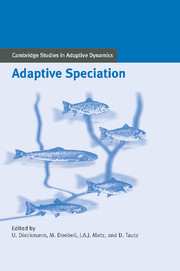Book contents
- Frontmatter
- Contents
- Contributing Authors
- Acknowledgments
- Notational Standards
- 1 Introduction
- 2 Speciation in Historical Perspective
- A Theories of Speciation
- 3 Genetic Theories of Sympatric Speciation
- 4 Adaptive Dynamics of Speciation: Ecological Underpinnings
- 5 Adaptive Dynamics of Speciation: Sexual Populations
- 6 Genetic Theories of Allopatric and Parapatric Speciation
- 7 Adaptive Dynamics of Speciation: Spatial Structure
- B Ecological Mechanisms of Speciation
- C Patterns of Speciation
- References
- Index
6 - Genetic Theories of Allopatric and Parapatric Speciation
Published online by Cambridge University Press: 05 July 2014
- Frontmatter
- Contents
- Contributing Authors
- Acknowledgments
- Notational Standards
- 1 Introduction
- 2 Speciation in Historical Perspective
- A Theories of Speciation
- 3 Genetic Theories of Sympatric Speciation
- 4 Adaptive Dynamics of Speciation: Ecological Underpinnings
- 5 Adaptive Dynamics of Speciation: Sexual Populations
- 6 Genetic Theories of Allopatric and Parapatric Speciation
- 7 Adaptive Dynamics of Speciation: Spatial Structure
- B Ecological Mechanisms of Speciation
- C Patterns of Speciation
- References
- Index
Summary
Introduction
In this chapter, first some key ideas and notions relevant to allopatric and parapatric speciation are outlined briefly and then mathematical models that describe these processes are discussed. The logic behind these scenarios of speciation, as well as the data that support them, are thoroughly discussed in numerous excellent reviews (e.g., Mayr 1942, 1963; White 1978; Brooks and McLennan 1991; Ridley 1993; Rosenzweig 1995; Futuyma 1998), which should be consulted for additional information. Three questions are reviewed:
▪ Which models are available to explain allopatric and parapatric speciation?
▪ What are their predictions regarding the dynamics of speciation?
▪ How robust are these conclusions under realistic biological settings?
With regard to models' predictions, a major focus is on the waiting time to speciation, which represents a fundamental characteristic of the speciation process; also, the waiting time to speciation is the quantity that we might be able to estimate from the fossil record. Here, consideration is given to how this time is expected to depend on different evolutionary factors and parameters, such as the rates of migration and mutation, the strength of selection for local adaptation, population size, spatial structure of the population, and the genetic architecture of reproductive isolation. A knowledge of these dependences enables the plausibility of different mechanisms of speciation to be evaluated. The focus here is mostly on simple models, mainly because simple mathematical models allow analytical investigations (rather than complex and/or numerically analyzed models) that lead to the most transparent conclusions and thus form the basis of our scientific understanding.
- Type
- Chapter
- Information
- Adaptive Speciation , pp. 112 - 139Publisher: Cambridge University PressPrint publication year: 2004
Accessibility information
- 6
- Cited by

